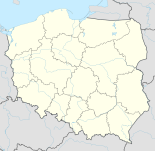Rębiszów
| Rębiszów | ||
|---|---|---|

|
|
|
| Basic data | ||
| State : | Poland | |
| Voivodeship : | Lower Silesia | |
| Powiat : | Lwówecki | |
| Gmina : | Mirsk | |
| Geographic location : | 50 ° 57 ' N , 15 ° 27' E | |
| Residents : | 694 (2010) | |
| Economy and Transport | ||
| Rail route : | Görlitz - Wroclaw | |
Rębiszów ( German : Rabishau ) is a village and formerly an independent office in the municipality of Mirsk ( Friedeberg am Queis ) in the Lower Silesian Voivodeship in Poland . Currently the place has about 700 inhabitants.
geography
Rębiszów is located in a low mountain range in the apron of the Giant Mountains . The train station in Mitteldorf is at an altitude of 327 m above sea level. The village area is crossed by several brooks, forest and arable land are equally available.
traffic
Rębiszów is on the Görlitz - Jelenia Góra - Wrocław railway line and has its own train station.
history
The place is first mentioned under the name Rabishau in the years 1303-1305 in chronicles. The name is supposedly derived from the numerous ravens that populated the Giant Mountains forest. Rabishau emerged as a scattered village with seven parts (Kirchberg, Mitteldorf (where the train station was later built), Fiebig, Oberdorf, Mühldorf, Niederdorf and the farms), which were called Zipfel, so that the locals spoke of the seven-pointed Rabishau. With most of the rest of Silesia Rabishau came at the time of Frederick the Great as a result of the Silesian wars of Prussia . In 1816 it was added to the newly established district of Löwenberg in Silesia , and from October 1, 1865, the Görlitz - Hirschberg - Breslau railway and with it the Rabishau train station began operations. On January 1, 1874, the Rabishau office was set up, which was administered by an office head .
With the railway, industry and tourism also found their way and complemented traditional agriculture and forestry. In addition to holidaymakers in the village itself, many travelers headed from the train station to the health resorts in the nearby Giant Mountains. There were also several wood factories and a basalt factory . At that time the community had an area of 1659.13 hectares , of which around 60% was used for agriculture. For the beginning of the 20th century the population is given as about 1,400, by 1946 it had grown to over 1,700, about 90% of whom were Lutheran . Rabishau was the third largest municipality in the Löwenberg district.
At the end of the Second World War , the municipality, like most of Silesia, was added to Poland . From July 16, 1946, the organized expulsion of the German residents began, who were deported leaving behind most of their property. Many of the expellees ended up in Holzminden , which became the godfather town of their old homeland, which after several name changes in quick succession was soon called Rębiszów. The municipality lost its independence and was added to the nearby Mirsk.
More than 500 displaced Rabishauers found a new home in Holzminden; There, in 1947, Paul Baumert, who was the mayor of Rabishau from 1918 to 1934, founded a refugee association , which he headed until 1962. Werner Daniel followed him.
Personalities
- Leberecht Baumert (1833–1904), German organist and composer
- Paul Kretschmer (1910–1999), German local politician
Web links
Individual evidence
- ↑ Główny Urząd Statystyczny, Portret miejscowości statystycznych w gminie Mirks (powiat lwówecki, województwo dolnośląskie) w 2010 r. Online query
- ↑ Daily Gazette from October 28, 2010: A Holzmindener with Silesian roots: Paul Kretschmer would have been 100 years old today
- ↑ without author: Rabishau , Bote aus dem Queistale February 1962, p. 10



